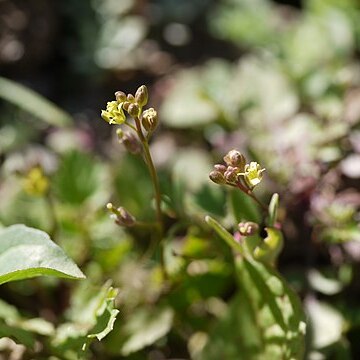Annuals; usually glabrous, rarely sparsely pubescent. Stems erect, unbranched or branched proximally or distally, (0.6-)2-6(-7.5) dm. Basal leaves not rosulate; blade margins pinnatifid. Cauline leaves petiolate (to 4 cm) or (distal) sessile; blade lyrate-pinnatipartite or undivided, obovate, oblong, or lanceolate, (lobes 0 or 1-5 (or 6) on each side), (2.5-)3.5-12(-16) cm × (8-)15-40(-50) mm, base auriculate or not, margins entire, irregularly crenate, or serrate, (entire or denticulate distally). Racemes elongated. Fruiting pedicels usually ascending or divaricate, rarely slightly reflexed, straight, (2-) 3-10(-15) mm. Flowers: sepals ascending, oblong-ovate, 2-3 × 0.8-1.5 mm; petals yellow, obovate or spatulate, (2.5-)3-4(-4.5) × 1-1.5 mm; median filaments 1.5-3 mm; anthers oblong, 0.5-0.8 mm. Fruits siliques, often curved-ascending, linear, (7-)10-24(-30) × 1-1.5(-2) mm; ovules (60-)70-110 per ovary; style (0.5-)1-1.5(-2) mm, (slender, narrower than fruit). Seeds biseriate or nearly so, reddish brown, ovate or ovate-orbicular, 0.5-0.9 mm (0.4-0.6 mm diam.), foveolate. 2n = 16, 24, 32, 48.
Low perennial 1–3 dm, essentially glabrous throughout; lvs mainly cauline, the principal ones petiolate, with lance-elliptic to lance-rhombic, merely toothed blade to 7 × 2 cm; pet 3 mm, slightly surpassing the sep; mature pedicels widely ascending; frs cylindric, upcurved, 1 cm, with a short, thick stylar beak 0.5(–1) mm. Native of se. Asia, sparingly intr. as a weed in N.Y. and elsewhere. May, June.
A cabbage family herb. It is an annual plant. It grows to 50 cm high. The leaves near the base are divided into lobes along the stalk. The lobes have teeth. For the leaves on the stem the largest lobe is at the end. The flowers are yellow. They occur in long stalks with many small flowers. The fruit is a pod. It is narrow and like a cylinder.

